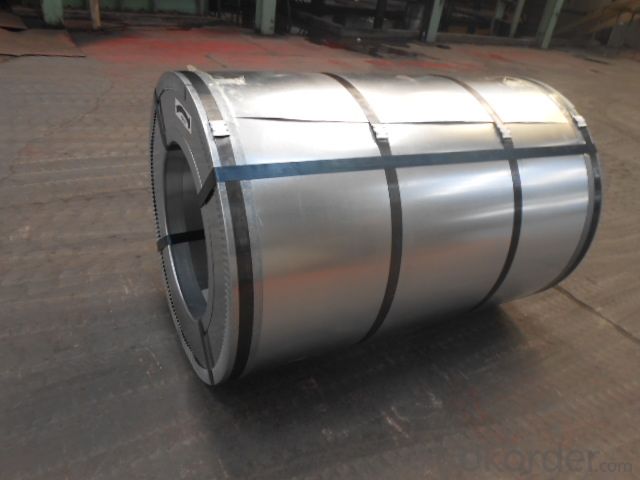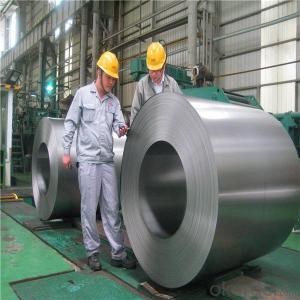Cold Rolled Steel Coil Good Quality of China
- Loading Port:
- Shanghai
- Payment Terms:
- TT or LC
- Min Order Qty:
- 50 m.t.
- Supply Capability:
- 10000 m.t./month
OKorder Service Pledge
OKorder Financial Service
You Might Also Like
1.Structure of Cold Rolled Steel Description:
The raw material of cold rolled steel coil/sheet is high quality hot rolled product, and after pickling continuous rolling, degreasing, annealing,skin pass,slitting and cut to length line etc. Along with it many kinds of new technology and new process of global cold rolling production have been applied. Therefore the quality of the goods could be guaranteed. The product is widely used in outdoor and interior decoration, furnishing manufacturing, home appliance, automobile etc.
2.Main Features of the Cold Rolled Steel:
• Excellent process capability
• Smooth and flat surface
• Workability, durability
• Excellent heat resistance performance
• High strength
• Good formability
• Good visual effect
3.Cold Rolled Steel Images

4.Cold Rolled Steel Specification
Standard:AISI,ASTM,DIN,GB,JIS,JIS G3302 ASTM 653M EN10142
Grade: Q195~Q345
Thickness: 0.16mm~1.5mm,0.16-1.5mm
Width: 1250,600-1250mm
Coil weight:3-12 MT
Coil ID:508/610mm
Chemical composition:
C | Si | Mn | Cr | Ni | P | S |
0.150 | 0.476 | 11.231 | 12.50 | 0.900 | 0.039 | 0.010
|
5.FAQ of Cold Rolled Steel
We have organized several common questions for our clients,may help you sincerely:
1.How about your company?
A world class manufacturer & supplier of castings forging in carbon steel and alloy steel,is one of the large-scale professional investment casting production bases in China,consisting of both casting foundry forging and machining factory. Annually more than 8000 tons Precision casting and forging parts are exported to markets in Europe,America and Japan. OEM casting and forging service available according to customer’s requirements.
2.How to guarantee the quality of the products?
We have established the international advanced quality management system,every link from raw material to final product we have strict quality test;We resolutely put an end to unqualified products flowing into the market. At the same time, we will provide necessary follow-up service assurance.
3. How long can we receive the product after purchase?
Usually within thirty working days after receiving buyer’s advance payment or LC. We will arrange the factory manufacturing as soon as possible. The cargo readiness usually takes 15-25 days, but the shipment will depend on the vessel situation.
- Q: How are steel coils affected by global trade policies?
- Steel coils are significantly affected by global trade policies as they are subject to various tariffs, quotas, and trade restrictions imposed by different countries. These policies can impact the cost, availability, and competitiveness of steel coils in the international market. Changes in trade policies can lead to fluctuations in demand and supply, impacting the prices and trade volumes of steel coils.
- Q: Where can I find a discount online for Stainless Steel Magnetic Knife Rack
- listed under are a number of them: 5.0 out of 5 stars could no longer be extra effective, March 3, 2006 by applying Denise M. Henderson (Groveland, CA united states of america) stable sturdy shape. seems great. common installation. appropriate length. Magnet appropriate capability. only confirm you place the back of the blade to the magnet first, then turn the knife flat onto the magnet. or you will cut back to rubble the knife blade. 5.0 out of 5 stars purchase it!, November a million, 2004 by applying T. Berktan (Le chef amateur) (Chicago, IL) i admire this knife holder. at first it rather is sanitary. would not take counter area and IT seems SO COOL on the wall. i might purchase it lower back with out hasitation if I had to. 5.0 out of 5 stars Very clever and seems great!! i like it!!, August 24, 2005 by applying Stacy S. Wooten i in my opinion, rather like this knife holder. It replaced into common to place up and seems great on my kitchen backsplash. it rather is long sufficient to hold all my knifes (approximately 8). it rather is a competent, stable magnet, and seems very stylish in my kitchen. i might surprisingly propose this product to everyone searching for a magnetic knife holder.
- Q: How are steel coils used in the production of metal panels?
- Metal panels require steel coils as an essential component in their production. These coils, typically made from high-quality steel, act as the raw material for manufacturing different types of metal panels. To initiate the production process, specialized machinery is used to unroll and flatten the steel coils. This process guarantees a consistent and uniform thickness throughout the sheet. Following this, the flattened steel is cut into the desired length and width, depending on the specific requirements of the metal panel being produced. After the steel has been cut, it undergoes further processing, including cleaning and coating. This step aims to eliminate any impurities and safeguard the steel against corrosion or damage. The coating also enhances the appearance of the metal panel and provides additional durability and longevity. Once the cleaning and coating process is complete, the steel sheets are shaped into the desired form using various techniques such as roll forming or stamping. This enables the creation of diverse metal panels, including roofing panels, wall panels, and decorative panels, among others. The selection of steel coils for metal panel production is based on their strength, durability, and versatility. Steel is renowned for its exceptional structural properties, making it the ideal material for constructing sturdy and long-lasting metal panels. Moreover, steel exhibits high resistance against environmental factors like extreme weather conditions, further enhancing the durability of the metal panels. In conclusion, steel coils play a critical role in the production of metal panels by serving as the raw material and undergoing various processes to ensure quality and durability. The utilization of steel coils enables the production of a wide range of metal panels suitable for various industries and applications.
- Q: What are the common coil widths and thickness combinations available for steel coils?
- The common coil widths and thickness combinations available for steel coils vary depending on the specific requirements and industry standards. However, there are some standard sizes that are commonly available in the market. For coil widths, the most common standard sizes range from 600mm to 2000mm. These widths are widely used in various industries such as automotive, construction, and manufacturing. However, custom widths are also available to meet specific project needs. As for the thickness combinations, steel coils are typically available in a range of thicknesses. The most common thicknesses for steel coils are between 0.4mm and 3mm. However, thicker or thinner options are available depending on the specific application. It is important to note that these standard sizes and thickness combinations may vary based on the specific steel grade, manufacturing process, and the supplier's capabilities. It is always recommended to discuss the required specifications with the supplier or manufacturer to ensure the availability of the desired coil widths and thickness combinations.
- Q: How are steel coils used in the production of industrial boilers?
- Steel coils are used in the production of industrial boilers as they are fabricated into various components such as tubes, headers, and drums. These coils provide strength and durability to withstand high pressure and temperature conditions in boilers. Additionally, the coils are often used for heat exchange purposes, ensuring efficient transfer of thermal energy within the boiler system.
- Q: How hot does steel have to get before it will melt?
- Type your query into Yahoo! Search or other search engines to get the answer: It depends, since steel usually has different metals added for various properties (strength, corrosive resistance, etc.)
- Q: How are steel coils cleaned?
- Steel coils are typically cleaned using a combination of mechanical and chemical methods. First, the coils are subjected to high-pressure water jets to remove any loose dirt, dust, or debris. Then, a specialized cleaning solution or detergent is applied to dissolve and remove any oil, grease, or stubborn stains. The coils are rinsed thoroughly to ensure the removal of all cleaning agents, followed by drying to prevent corrosion.
- Q: I have samurai sword that is a replica of the kill bill sword. It says on the blade stainless steel, what can i use to shine and protect blade. It had and still does a wax.like coating on the blade sine i received it. Thx for ur help
- i like how you asked this in the Card Games section.
- Q: What are the different methods of coil handling and storage?
- Various industries commonly employ several different methods for coil handling and storage to ensure safety, efficiency, and preservation. Some of these methods include: 1. Coil cradles: Popular for handling and storing coils, coil cradles feature a U-shaped structure that provides stability and support. The cradle is positioned beneath the coil and can be easily maneuvered using forklifts or overhead cranes. 2. Coil cars: Used for transporting coils within a facility or between locations, coil cars are equipped with specialized clamps or arms to securely hold the coil during transit. Manual or automatic operation is determined by coil size and weight. 3. Coil racks: Specifically designed storage systems for organized coil storage, coil racks are typically constructed from steel and feature multiple levels or compartments to accommodate various coil sizes and types. Forklifts or overhead cranes are used to access coil racks. 4. Coil turnstiles: In processing lines where continuous coil feeding into machines is required, coil turnstiles are employed. These rotating devices enable easy loading and unloading of coils by rotating them to the desired position, facilitating handling and processing. 5. Coil pallets: Specially designed pallets made of steel or wood, coil pallets are utilized for both storage and transportation of coils. Their unique configuration allows for convenient loading and unloading using forklifts or pallet jacks. Coil pallets are often utilized for long-distance transportation or warehouse storage. 6. Coil storage racks: Large storage systems designed for bulk coil storage, coil storage racks are typically made of steel and feature multiple levels or compartments to accommodate a significant number of coils. Forklifts or overhead cranes are utilized for accessing coil storage racks. These examples represent only a selection of the numerous coil handling and storage methods commonly employed across various industries. The specific method chosen depends on factors such as coil size and weight, available space, and industry-specific requirements.
- Q: When maintaining a japanese knife: Is a honing steel still necessary if I have a fine 3000/8000 grit whetstone?which do you prefer?
- A steel is to clean off an edge and remove any bends on the bevel, it is not directly for sharpening as it removes no material from the knife (or should not). A whetstone, however fine, does remove material. A steel to maintain an edge, a stone to restore an edge. They are different items for different purposes.
Send your message to us
Cold Rolled Steel Coil Good Quality of China
- Loading Port:
- Shanghai
- Payment Terms:
- TT or LC
- Min Order Qty:
- 50 m.t.
- Supply Capability:
- 10000 m.t./month
OKorder Service Pledge
OKorder Financial Service
Similar products
Hot products
Hot Searches
Related keywords




























